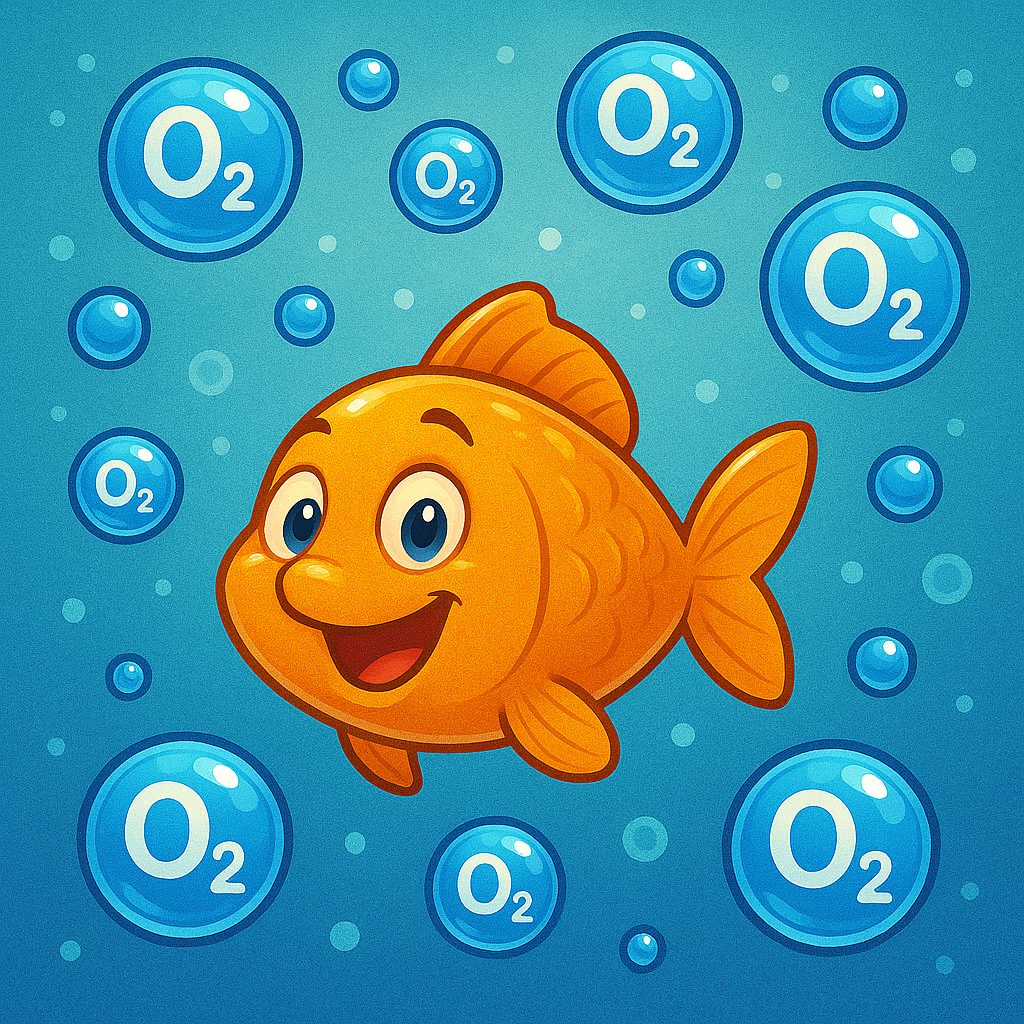Aquarium Surface Agitation & Oxygenation Guide
🌊 Aquarium Surface Agitation & Oxygenation Guide
🧠 The Science of Gas Exchange
- Where O₂ enters: only at the air–water interface.
- Driving forces:
- 🌡 Temperature: warm water holds less O₂ (28 °C saturation ~7.5 mg/L; 30 °C ~7.3 mg/L).
- 🐟 Bioload: more fish = more O₂ consumed.
- 🧫 Microbes: bacteria in filters, detritus, and biofilm demand O₂ constantly.
- 🌱 Plants/algae: produce O₂ during the day (photosynthesis), but consume O₂ at night.
- Surface agitation reduces the boundary layer of still water at the surface, replacing O₂-depleted water with bulk tank water. This accelerates diffusion.
✅ Signs of Adequate Agitation
- 👀 Visual:
- Rippling or wave action across most of the surface.
- Water looks “alive,” not mirror-flat.
- 🫧 Hardware output:
- Canister spray bar angled upward creating a line of surface disturbance.
- HOB filter waterfall splashing and aerating.
- Airstones bubbling → bubbles rise, pull water up, and disturb surface.
- 🐟 Animal behavior:
- Fish distribute normally throughout the water column.
- No “piping” (hovering near surface to gulp O₂).
- 🧪 Measurement:
- Dissolved oxygen probe shows ≥ 6.5 mg/L in tropical tanks.
- For sensitive species (stingrays, discus, large plecos), aim for ≥ 7.0 mg/L.
⚠️ Warning Signs of Insufficient Oxygenation
- 🐠 Fish cluster near the surface, especially at night.
- 🌀 Dead spots in tank with no circulation (food and feces settle un-moved).
- 🌙 Nighttime stress (plants/CO₂ injection consuming O₂).
- 🌡 Warm summer water — reduced O₂ solubility + higher fish metabolism.
- 🧫 Overfeeding/detritus → bacterial blooms strip O₂ faster than fish alone.
🧮 Rough Oxygen Demand Estimates
- Community fish (tetra/guppy/cory mix): ~150–200 mg O₂/kg/h.
- Large cichlids, plecos: ~200–250 mg O₂/kg/h.
- Stingrays/monster fish: ~250–300 mg O₂/kg/h.
- Rule of thumb: each additional 100 g of fish biomass adds ~20–30 mg O₂ demand/hour at tropical temps.
📊 Agitation & Flow Targets
- Community tanks: 4–6× tank turnover/hour + visible rippling.
- Heavy bioload tanks: 8–10× turnover/hour, with at least one return breaking the surface.
- Planted tanks with CO₂: strike a balance — you want gentle rippling, not whitecaps, so you don’t gas off CO₂ too quickly.
- Monster/ray systems: maximize churn — multiple air stones or wavemakers pointed up to keep 100% of surface rolling.
🛠️ How to Increase Agitation
- 🔄 Angle filter outlets upward: spray bars or canister returns breaking the surface.
- 🪣 Hang-on-back filters: let water fall and splash (not below waterline).
- 🫧 Air stones/sponge filters: bubbles rise, drag water up, churn surface.
- 🌊 Wavemakers/powerheads: aim slightly upward for rolling surface motion.
- ⚡ In emergencies: manually scoop and pour tank water from a jug to break surface tension.
🧪 How to Test If You Have Enough
With DO meter (best)
- Place probe mid-tank.
- Target: 6.5–7.5 mg/L at 26–28 °C.
- If DO <6.0 mg/L → increase agitation or reduce bioload.
Without DO meter
Use a 3-part checklist:
- 👀 Visual — Ripples/waves across entire surface? If flat = inadequate.
- 🐟 Behavior — Fish calm and distributed normally? If at surface, DO low.
- 🛠️ Hardware — At least one return/air source constantly breaking surface? If not, add one.
🚦 Quick Reference Chart
| Condition | Agitation Level | DO Target | Action |
|---|---|---|---|
| ✅ Healthy community tank | Light rippling (50–70% surface) | ≥6.5 mg/L | OK |
| ⚠️ Heavy pleco/cichlid load | Strong rippling (70–90%) | ≥7.0 mg/L | Add air stone/wavemaker |
| 🚫 Monster/ray system | 100% rolling surface + multiple air inputs | ≥7.0–7.5 mg/L | Backup battery/generator strongly advised |
| ❗ Power outage | Flat surface, no circulation | <4.0 mg/L in hours | Use battery pump/ice/stirring |
🧯 Safety Margins
- Always design aeration so your system can handle 2× your current biomass — fish grow!
- In hot months, add redundant air pumps (battery backups).
- For rays/large plecos, treat surface agitation + DO >7.0 mg/L as non-negotiable.
✅ Bottom line: You should see constant rippling across nearly the entire surface of your tank. If you only see a mirror-flat surface with fish near the top, you need more agitation.

Powered by Lightspeed
Display prices in:USD